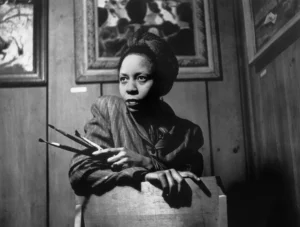Join us for a family friendly afternoon of celebrating and learning more about the legacy and art practice of Dr. Burroughs!
We’re excited to share this day viewing specially selected works by Dr. Burroughs from the SSCAC Archives and Collections Department, as well as rotational screenings of interviews and talks featuring Dr. Burroughs, and locally published print works and projects exploring her practice and legacy. Dr. Burroughs artwork coloring sheets will be available for a fun family activity!
Margaret Taylor-Burroughs (November 1, 1915 – November 21, 2010), also known as Margaret Taylor Goss, Margaret Taylor Goss Burroughs or Margaret T G Burroughs; was an African-American artist and writer and a co-founder of the DuSable Museum of African American History. She also helped to establish the South Side Community Art Center, where at the age of 23 Burroughs served as the youngest member of its board of directors. Dr. Burroughs was also prolific in her dedication to teaching creative writing and art at Stateville Prison for over 25 years paving the way and creating an inspirational example for what is now the Prison + Neighborhood Arts/Education Project.





